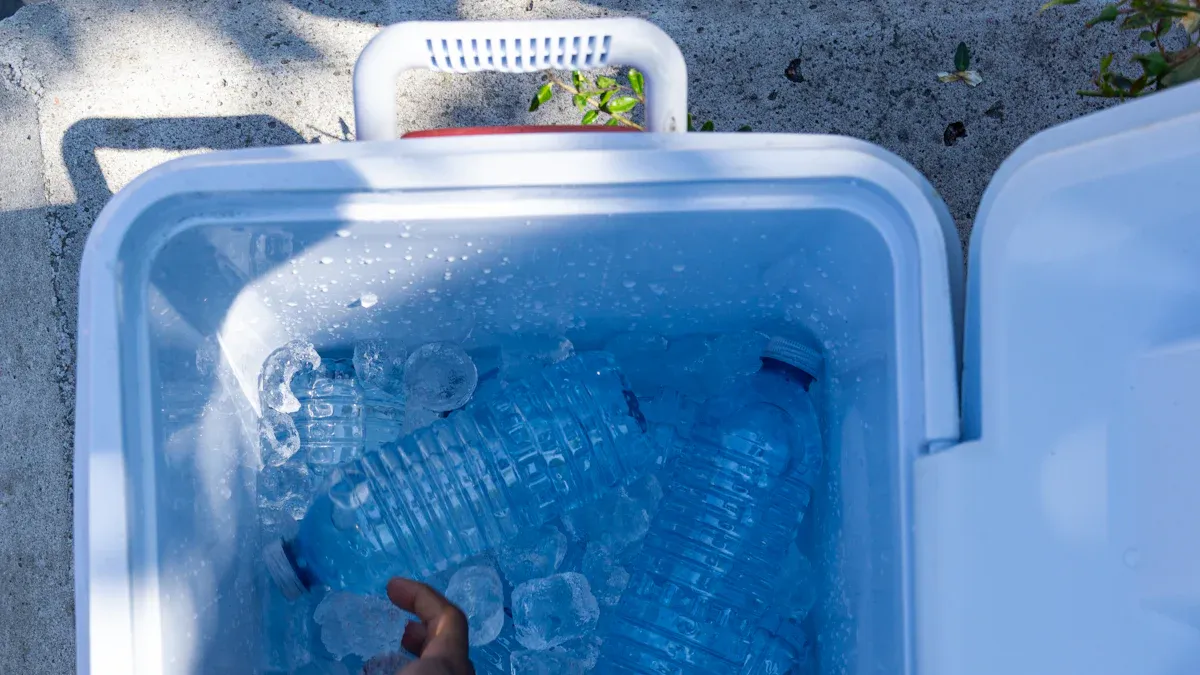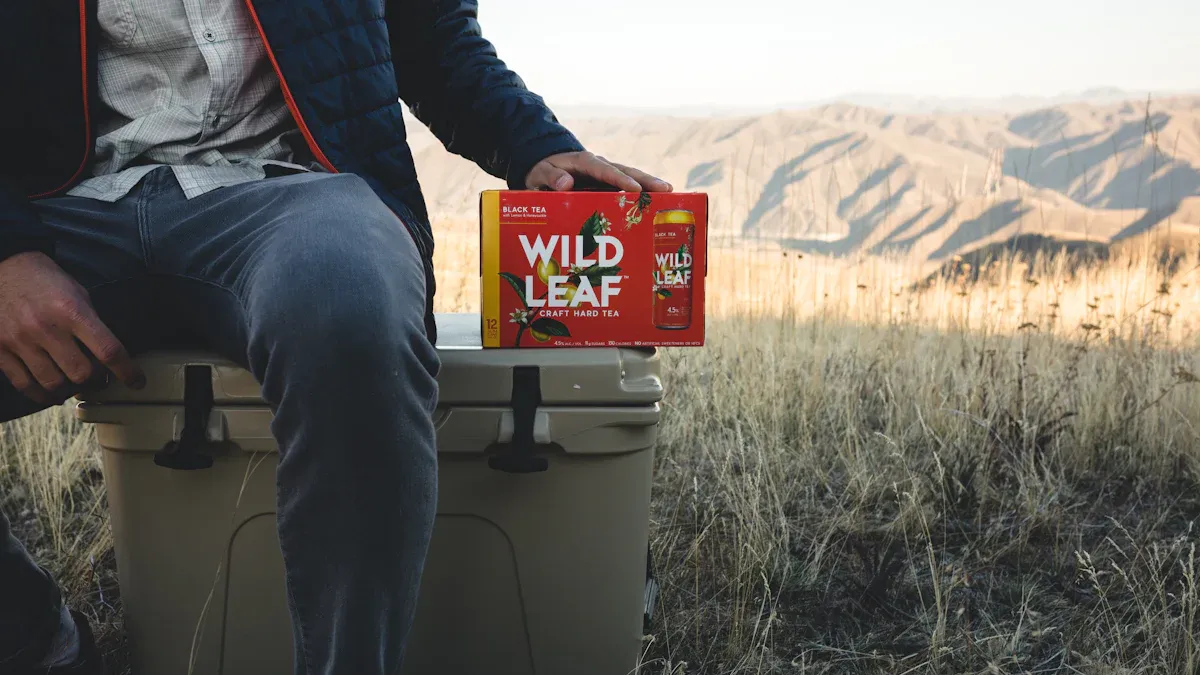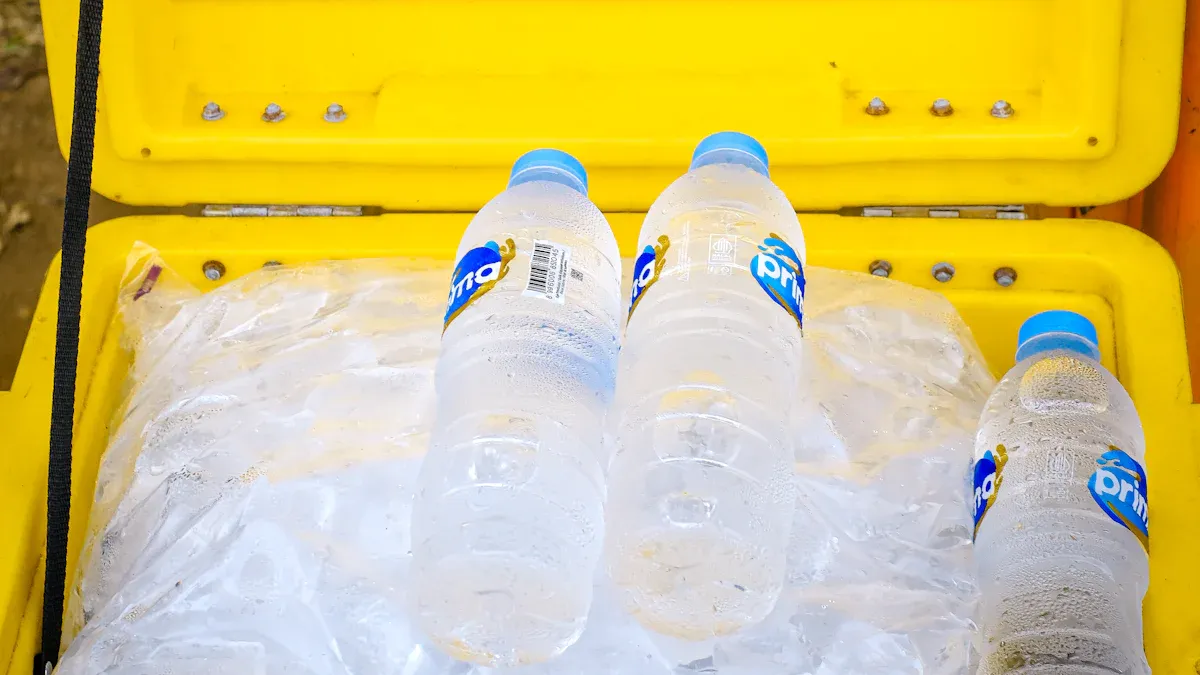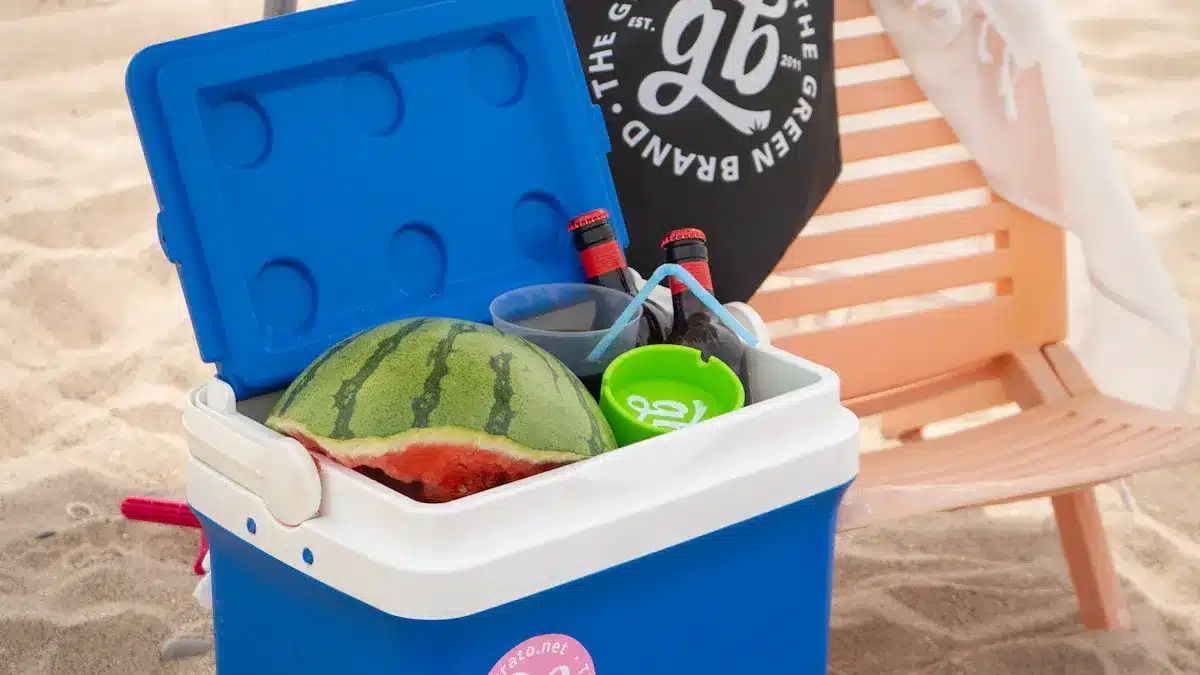

When you use a hard plastic lunch cooler the right way, you keep your food fresh and safe. If you ignore the basics, your lunch could spoil, and you might even get sick. A hard plastic lunch cooler can last for years if you treat it well. Don’t let small mistakes cost you your health or money.
Key Takeaways
- Hard plastic lunch coolers are tough, long-lasting, and easy to clean, making them ideal for keeping food fresh and safe.
- Use ice packs and pre-chill your cooler to keep food cold for many hours, and always store the cooler in the shade to maintain temperature.
- Clean your cooler after every use with mild soap or safe disinfectants to prevent bacteria and bad odors.
- Pack your lunch smartly by layering cold items and filling empty spaces with ice to maximize cooling efficiency.
- Choose BPA-free, food-grade materials and check your cooler regularly for damage to ensure food safety and cooler durability.
Hard Plastic Lunch Cooler Durability and Materials

Hard Plastic vs. Soft Lunch Boxes
When you pick a lunch box, you might wonder if you should go with a hard plastic lunch cooler or a soft one. Each type has its own strengths. Hard plastic lunch coolers are tough. They can handle bumps, drops, and rough use. Many are rotomolded, which means they are built to last even in harsh outdoor conditions. You can use them for years without seeing much wear.
Soft lunch boxes, on the other hand, use materials like water-resistant fabric. These are lighter and easier to carry. You might like them for short trips or school lunches. But soft lunch boxes can show signs of wear faster. The fabric can tear, and the seams might come apart after a lot of use.
Here’s a quick look at how some popular lunch boxes compare:
| Cooler Model | Common Materials Used | Durability Features and Ratings |
|---|---|---|
| Pelican 8QT Personal Cooler & Dry Box | BPA-free hard plastic exterior and construction | Highly durable; designed to withstand rough handling, bumps, and scrapes; compact and portable with secure latch. |
| LL Bean Lunch Box | Tough packcloth exterior with BPA- and PVC-free lining | Durable against daily rough use; easy-to-clean interior; tested for safety against harmful chemicals. |
| RTIC Ice Lunch Bag | BPA-free, food-safe gel baffles; durable high-quality fabric | Durable fabric construction; environmentally friendly; maintains cold temperatures effectively. |
| Hydro Flask Kids Insulated Lunch Box | Rigid interior with FDA food-grade hard plastic lining | Hard plastic interior is easy to clean, resists residual smells; generally high durability due to rigid plastic. |
You can see that hard plastic models stand out for their toughness and long life. Soft lunch boxes focus more on being light and easy to carry.
Material Strengths and Weaknesses
You want your lunch boxes to last. Hard plastic materials, like those used in many top coolers, resist punctures and are easy to clean. They do not hold onto smells, so your food always tastes fresh. Soft lunch boxes, while handy, can be harder to clean, especially around seams. They may also dry slower if they get wet.
Hard plastic lunch coolers often use BPA-free and food-safe plastics. These materials keep your food safe and cold. They also make cleaning simple. Soft lunch boxes use water-resistant fabric, which helps with spills but does not match the durability of hard plastic.
Keep in mind, making plastic products does have an impact on the environment. The process uses energy and creates waste. Most plastics come from fossil fuels, and not all of them get recycled. Still, a hard plastic lunch cooler can last much longer than a soft one, so you may need to replace it less often.
Insulation and Temperature Control in Insulated Lunch Boxes

How Hard Plastic Lunch Coolers Keep Food Cold
You want your food to stay fresh and safe until lunchtime. That’s where insulated lunch boxes really shine. Most hard plastic lunch coolers use a tough outer shell and a thick layer of insulation inside. This insulation is often made from polyurethane foam or even vacuum-sealed layers. These materials slow down the transfer of heat, so cold air stays inside and warm air stays out.
Scientists have found that polyurethane foam and vacuum insulation work well for keeping food cold. The foam traps air, which is a poor conductor of heat. Some lunch boxes even use Styrofoam, which has a high R-value and can keep ice frozen for days. You get better results when you use gel packs or ice packs with your cooler. They help keep the temperature below 40°F, which is the safe zone for most foods.
Let’s look at how long different lunch boxes can keep your food cold:
| Lunch Cooler Model | Duration Below 40°F (hours) | Conditions/Notes |
|---|---|---|
| Yeti Hopper Flip 8 | Just over 6.5 | With ice packs, tested under outdoor conditions |
| L.L. Bean Lunch Box | About 2.5 | With additional ice packs |
| Yeti Daytrip Lunch Bag | Just under 5 | With two additional ice packs |
| Titan by Arctic Zone (Titan line) | 6 to 8 | Claims based on insulation and ice packs |
| PackIt Freezable Classic Lunch Box | Over 6 (often until afternoon) | Freezable interior, tested with ice packs |

You can see that some insulated lunch boxes, like the Titan by Arctic Zone, keep food below 40°F for up to 8 hours when you use gel packs. That’s perfect for a full day at work, school, or even a picnic.
Tips to Maximize Insulation Performance
You can get the most out of your hard plastic lunch cooler by following a few simple tips. These steps help you keep your food cold for as long as possible:
- Pre-chill your cooler. Fill it with ice and water for a few hours before you pack your food. Dump out the water right before you load your lunch.
- Use gel packs or frozen food at the bottom. Layer your food and ice packs to keep everything cold.
- Fill empty spaces with extra ice cubes or more gel packs. Air pockets let warm air move around, which makes your food warm up faster.
- Top your cooler with a freezer sheet or a damp towel. This traps cold air inside.
- Organize your food by meal or snack. Make a quick plan so you don’t have to open the cooler for long.
- Keep your cooler in the shade. Sunlight heats up the outside and makes it harder for the insulation to work.
- Close the cooler as soon as you grab what you need. Every time you open it, warm air sneaks in.
- Carry your cooler inside your car, not in the trunk or on the roof. The inside of a car stays cooler than the trunk or roof on a hot day.
Tip: Choose a cooler that fits your food closely. Less empty space means better insulation and longer-lasting cold.
Insulated lunch boxes usually have several layers. The outer layer keeps water out. The middle layer, made of foam or reflective material, does most of the insulating. The inner layer is waterproof and easy to clean. Zipper closures work better than Velcro for keeping cold air in.
If you follow these steps, you’ll have no trouble keeping lunch cool all day. You’ll also help your food stay safe and tasty, no matter where you go.
Cleaning and Maintenance for Hard Plastic Lunch Coolers
Best Cleaning Practices
You want your hard plastic lunch cooler to stay fresh and last a long time. Cleaning it the right way makes a big difference. Start by turning your cooler upside down and shaking out any crumbs or loose bits. Next, grab some Clorox™ Free & Clear Compostable Cleaning Wipes and wipe down both the inside and outside. If you see any sticky spots or stains, spray a little Clorox™ Free & Clear Multi-Surface Spray Cleaner and wipe it clean.
For a deeper clean, use Clorox™ Free & Clear Disinfecting and Sanitizing Mist. Spray the inside until it looks wet. Let it sit for two minutes. This step helps kill germs and keeps your cooler safe for food. You can let it air dry or wipe it dry with a clean towel. No rinsing is needed, which saves you time.
Tip: Always follow the directions on your cleaning products. These steps are safe for use around food and kids.
Common Mistakes That Damage Lunch Boxes
You might not realize it, but some habits can hurt your lunch boxes. Leaving your cooler in direct sunlight can warp the plastic and make it less effective at keeping things cold. Using sharp tools to break up ice inside can scratch or even puncture the interior. Slamming the lid shut can break the hinges or seals, which lets cold air escape.
Storing your cooler with leftover ice or water can cause mold and mildew to grow. This leads to bad smells and can damage the cooler. Always clean and dry your cooler before putting it away. Using harsh chemicals like bleach can also cause problems. If you use bleach, rinse it off right away and never leave your cooler in the sun after cleaning. Bleach can discolor and weaken the plastic if you are not careful.
Remember, a little care goes a long way. Treat your cooler well, and it will keep your food safe and fresh for years.
Safety and Food Hygiene with Insulated Lunch Boxes
Preventing Cross-Contamination and Bacteria
You want your lunch to be safe and tasty. Harmful bacteria can grow fast if you do not handle food the right way. When perishable foods sit between 40°F and 140°F, bacteria can double in just 20 minutes. That is the danger zone for food. If you leave your lunch out for more than two hours, or one hour on a hot day, it can become unsafe.
Here are some simple ways to keep your food safe:
- Wash your hands before and after you pack or eat your lunch.
- Clean your lunch box every day. Use soap and water or a safe disinfectant.
- Always use cold packs or frozen water bottles to keep food cold.
- Separate raw foods from ready-to-eat foods. Use different containers for each.
- Do not put food directly on cooler surfaces. Use paper towels or wax paper as a barrier.
- Teach kids to throw away leftovers after lunch.
Food safety specialists say you should always keep perishable foods below 40°F. This slows down bacteria and keeps your lunch safe. If you use at least two cold sources, like ice packs, you help your cooler do its job.
Safe Storage for Different Foods
Packing your lunch the right way keeps everything fresh. Some foods need extra care. Deli meats, cheese, milk, and yogurt must stay cold. Do not leave them at room temperature for more than two hours. On hot days, keep them cold for no more than one hour.
Check out this table for safe plastic types for food storage:
| Plastic Type | Plastic Code | Safety for Food Storage | Recommended Use | Notes |
|---|---|---|---|---|
| Polypropylene (PP) | 5 | Safe, food-grade, BPA-free | Microwave-safe containers with lids | Best for reheating and long-term storage |
| High-Density Polyethylene (HDPE) | 2 | Safe, food-grade, BPA-free | Milk jugs, storage bins, long-term food storage | Durable and safe for various foods |
| Low-Density Polyethylene (LDPE) | 4 | Safe, food-grade, BPA-free | Freezer bags, flexible food wraps | Good for cold storage |
| Polyvinyl Chloride (PVC) | 3 | Unsafe | Cling wraps, some storage bins | Can leach harmful chemicals, avoid for food storage |
| Polystyrene (PS) | 6 | Unsafe for hot food | Takeout boxes, disposable containers | Not safe for hot food storage |
| Mixed Plastics | 7 | Potentially unsafe | Cheap plastic boxes and bins | May contain BPA, avoid for food storage |

Use BPA-free, microwave-safe, and freezer-safe containers. Do not use scratched or worn plastic containers. Always pack at least two cold sources in your hard plastic lunch cooler. Keep your cooler in the shade and close the lid quickly after opening. These steps help keep your food safe and fresh until lunchtime.
Usage Tips and Extending the Life of Your Hard Plastic Lunch Cooler
Packing for Maximum Efficiency
You want your food to stay cold and fresh, right? Packing a meal the smart way makes all the difference. Start by removing extra packaging and pre-chop your food at home. This saves space and helps you fit more into your cooler. Freeze anything you can, like juice boxes or yogurt tubes, before you pack. Frozen items act as extra ice packs and keep everything chilly.
Before you load your lunch boxes, chill your cooler with ice or frozen water bottles for a few hours. When you’re ready, place block ice or frozen packs at the bottom. Cold air sinks, so put your most perishable foods right on top of the ice. Next, layer your food and ice, filling any empty spots with crushed ice or small ice packs. This keeps air from warming up your food.
Pack your food in reverse order. Place the things you’ll eat last at the bottom and snacks or drinks on top. If you use a large cooler, make a quick map or list so you can grab what you need fast. Finish with an ice sheet or reusable ice packs on top to seal in the cold. Now you’re ready to enjoy a safe, tasty meal from home.
Storage and Handling Tips
Taking care of your hard plastic lunch cooler helps it last for years. Always use food-grade plastics like HDPE for storing your food. Keep your cooler out of direct sunlight and away from high heat. Sunlight can weaken the plastic and make it less safe for your food.
Check your lunch boxes often for cracks or signs of wear. Replace them if you see damage. Use block ice instead of cubes to keep things cold longer. Place ice under racks and food on top for better cooling. Keep the drain closed unless you need to empty water. This stops warm air from sneaking in.
Try to open your cooler only when you need something. Every time you open it, cold air escapes. Store your cooler in a cool, shaded spot. Don’t drain melted ice water right away—the cold water helps keep your food safe. With these habits, you’ll get the most out of your cooler every time you pack for school, work, or a picnic.
Tip: Treat your cooler gently and clean it after each use. You’ll keep your lunch boxes fresh and ready for your next adventure.
When Not to Use a Hard Plastic Lunch Cooler
Situations Where Other Lunch Boxes Are Better
You might love your hard plastic lunch cooler, but sometimes it just isn’t the best choice. Think about what you need for your day. If you want something light and easy to carry, a soft lunch box could work better. Soft lunch boxes fold up when empty, so you can tuck them into your backpack or suitcase without taking up much space. That’s super handy if you’re short on storage or traveling.
Experts say soft coolers shine when you care more about portability than keeping things cold for a long time. Maybe you’re heading to school, a quick picnic, or a short trip. You don’t need your food to stay cold all day—just for a few hours. Soft lunch boxes also come with extra pockets and backpack straps. You can stash utensils, napkins, or snacks in those pockets, making your lunch even easier to organize.
Tip: If you plan to leave your lunch in your car or need to squeeze your cooler into a tight spot, a soft-sided cooler is a smart pick.
Hard plastic lunch coolers can feel heavy, even before you pack them. Carrying one for a long walk or up several flights of stairs might wear you out. Their rigid shape also means you need more room to store them when you’re not using them. If you live in a small apartment or dorm, that can be a hassle.
Here are some times when you might want to skip the hard plastic cooler:
- You need to save space in your bag or locker.
- You want something lightweight for a short trip.
- You don’t need to keep food cold for more than a few hours.
- You want extra pockets for utensils or snacks.
- You plan to carry your lunch in a backpack or tight space.
Traditional hard plastic coolers can also struggle in extreme heat or cold. Some plastics may crack or warp if left in a hot car or freezing garage. If you expect wild temperature swings, check the material of your cooler or consider a soft-sided option for peace of mind.
Choosing the right lunch box depends on your needs. Sometimes, a soft lunch box just fits your day better.
Recommended Hard Plastic Lunch Coolers: KUER and Top Picks
KUER Hard Plastic Cooler Overview
If you want a cooler that stands out from the crowd, KUER is a name you should know. You get advanced rotomolded construction, which means your cooler can handle drops, bumps, and rough days outside. KUER coolers have thick foam insulation and airtight seals. This combo keeps ice for over eight hours, even when it’s hot outside. That’s a big win if you need your lunch to stay cold all day.
You’ll notice KUER coolers feel sturdy and rugged. Cleaning them is easy, and you can use them for camping, work, or school. The design is compact but still gives you plenty of space for your food and drinks. Carrying one is simple because they’re lightweight and have ergonomic handles.
KUER puts a lot of effort into quality. Their team uses advanced manufacturing and strict quality checks. With over 50 patents, you see real innovation in every cooler. KUER even offers a 5-year free warranty, showing they believe in their product’s durability. If you want one of the best lunch boxes for daily use or travel, KUER is a smart pick.
Tip: KUER coolers pass tough tests like hinge overextension and drop tests, so you know they’re built to last.
Other Top Picks and What to Look For
You have lots of choices when searching for the best lunch boxes. Here’s a quick look at some top-rated hard plastic coolers and what makes them special:
| Cooler Model | Ice Retention | Size/Capacity | Durability & Features | Extra Perks |
|---|---|---|---|---|
| Pelican 8QT Personal Cooler | 24 hours | Compact, fits lunch and drinks | Sturdy latch, weatherproof seal | Dry storage, easy to carry |
| Pelican 14QT Lunchbox Cooler | 36 hours | Room for lunch, ice, and drinks | Removable tray, strong build | Bottle opener, magnetic cap catcher |
| Pelican 20QT Elite Cooler | 2 days | Larger, for extended use | Built tough, 3-year warranty | Enhanced insulation |
When you choose the best lunch boxes, look for long ice retention, strong latches, and easy-to-carry designs. Warranties and extra features like dry storage or bottle openers make your lunch cooler even more useful. Brands like Arctic Zone, Thermos, and YETI also offer solid warranties and helpful customer support, so you can buy with confidence.
You’ve learned the most important facts for using hard plastic lunch coolers. Here’s what you should always remember:
- Pick BPA-free, food-grade materials to keep your meals safe.
- Use leak-proof seals and secure closures to stop spills and keep food fresh.
- Clean your cooler with mild soap and dry it well to prevent mold and odors.
- Separate foods and wash your hands to avoid cross-contamination.
- Choose coolers with strong insulation and check them often for damage.
Sanitizing your cooler with disinfectant wipes lowers the risk of bacteria like E. coli and Listeria. Hard plastic coolers protect your food and help it last longer. When you follow these tips and choose a trusted brand like KUER, you keep your food safe and your cooler working for years.
FAQ
How do you keep food cold in a hard plastic lunch cooler all day?
You should use ice packs or frozen water bottles. Pack cold food close together. Keep the cooler closed as much as possible. Store it in the shade. Pre-chill your cooler before packing for best results.
Can you put hot food in a hard plastic lunch cooler?
Yes, you can. Wrap hot food in foil or use insulated containers. The cooler will help keep it warm for a few hours. Don’t mix hot and cold foods in the same cooler.
How often should you clean your lunch cooler?
You should clean your cooler after every use. Wipe the inside and outside with mild soap and water. Dry it completely before storing. This keeps your cooler fresh and safe for food.
What foods should you not pack in a hard plastic lunch cooler?
Avoid packing foods that spoil quickly, like raw fish or dairy, if you can’t keep them cold. Don’t pack foods with strong smells unless sealed tightly. Always use leak-proof containers for liquids.
Can you use a hard plastic lunch cooler for drinks only?
Absolutely! Hard plastic lunch coolers work great for keeping drinks cold. Add ice packs or ice cubes. Arrange bottles or cans upright to prevent spills. Enjoy cold drinks all day.




